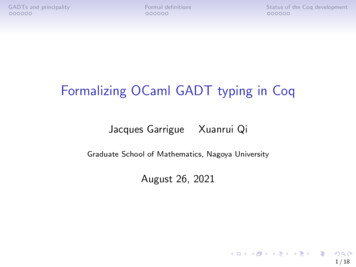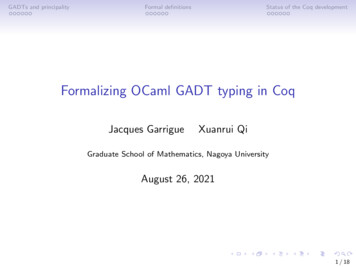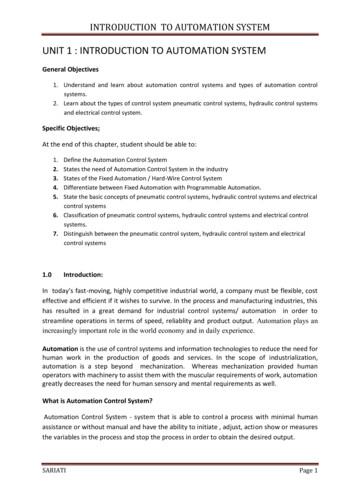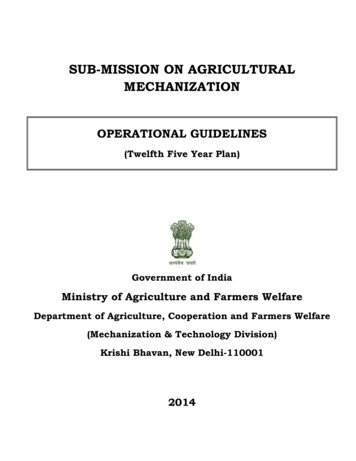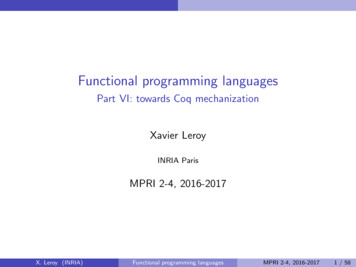
Transcription
Functional programming languagesPart VI: towards Coq mechanizationXavier LeroyINRIA ParisMPRI 2-4, 2016-2017X. Leroy (INRIA)Functional programming languagesMPRI 2-4, 2016-20171 / 58
Prologue: why mechanization?Why formalize programming languages?To obtain mathematically-precise definitions of languages.(Dynamic semantics, type systems, . . . )To obtain mathematical evidence of soundness for tools such astype systems (well-typed programs do not go wrong)type checkers and type inferencestatic analyzers (e.g. abstract interpreters)program logics (e.g. Hoare logic, separation logic)deductive program provers (e.g. verification condition generators)interpreterscompilers.X. Leroy (INRIA)Functional programming languagesMPRI 2-4, 2016-20172 / 58
Prologue: why mechanization?Challenge 1: scaling upFrom calculi (λ, π) and toy languages (IMP, MiniML) to real-worldlanguages (in all their ugliness), e.g. Java, C, JavaScript.From abstract machines to optimizing, multi-pass compilers producingcode for real processors.From textbook abstract interpreters to scalable and precise static analyzerssuch as Astrée.X. Leroy (INRIA)Functional programming languagesMPRI 2-4, 2016-20173 / 58
Prologue: why mechanization?Challenge 2: trusting the mathsAuthors struggle with huge LaTeX documents.Reviewers give up on checking huge but rather boring proofs.Proofs written by computer scientists are boring:they read as if the author is programming the reader.(John C. Mitchell)Few opportunities for reuse and incremental extension of earlier work.X. Leroy (INRIA)Functional programming languagesMPRI 2-4, 2016-20174 / 58
Prologue: why mechanization?Opportunity: machine-assisted proofsMechanized theorem proving has made great progress in the last 20 years.(Cf. the monumental theorems of Gonthier et al: 4 colors,Feit-Thompson.)Emergence of engineering principles for large mechanized proofs.The kind of proofs used in programming language theory are a goodmatch for theorem provers:large definitions, many casesmostly syntactic techniques, no deep mathematics concepts.X. Leroy (INRIA)Functional programming languagesMPRI 2-4, 2016-20175 / 58
Prologue: why mechanization?The POPLmark challengeIn 2005, Aydemir et al challenged the POPL community:How close are we to a world where every paper on programminglanguages is accompanied by an electronic appendix withmachine-checked proofs?12 years later, about 20% of the papers at recent POPL conferences comewith such an electronic appendix.X. Leroy (INRIA)Functional programming languagesMPRI 2-4, 2016-20176 / 58
Prologue: why mechanization?Proof assistants1A formal specification language to write definitions and statetheorems.2Commands to build proofs, often in interaction with the user someproof automation.3Often, an independent, automatic checker for the proofs thus built.Popular proof assistants in programming language research:Coq, HOL4, Isabelle/HOL.X. Leroy (INRIA)Functional programming languagesMPRI 2-4, 2016-20177 / 58
Examples of mechanizationOutline1Prologue: why mechanization?2Examples of mechanization3Bound variables and alpha-conversionde Bruijn indicesHigher-Order Abstract SyntaxNominal approachesLocally namelessX. Leroy (INRIA)Functional programming languagesMPRI 2-4, 2016-20178 / 58
Examples of mechanizationExamples of Coq mechanizationSee the commented Coq development on the course Web site.ModuleContentsSequencesLibrary on sequences of transitionsSemanticsSmall-step and big-step semantics;equivalence proofsLeroy’s lecture #1TypingSimply-typed λ-calculus and typesoundness proofRémy’s lecture #1CompilerCompilation to Modern SECD andcorrectness proofLeroy’s lecture #2CPSCPS conversion and correctness proofLeroy’s lecture #3X. Leroy (INRIA)From lectureFunctional programming languagesMPRI 2-4, 2016-20179 / 58
Examples of mechanizationCoq in a nutshell, 1: Computations and functionsA pure functional language in the style of ML, with recursive functionsdefined by pattern-matching.Fixpoint factorial (n: nat) : match n with O 1 S p n * factorial pend.Fixpoint concat (A: Type) (l1 l2: list A) : match l1 with nil l2 h :: t h :: concat t l2end.Note: all functions must terminate.X. Leroy (INRIA)Functional programming languagesMPRI 2-4, 2016-201710 / 58
Examples of mechanizationCoq in a nutshell, 2: mathematical logicThe usual logical connectors and quantifiers.Definition divides (a b: N) : exists n: N, b n * a.Theorem factorial divisors:forall n i, 1 i n - divides i (factorial n).Definition prime (p: N) : p 1 /\ (forall d, divides d p - d 1 \/ d p).Theorem Euclid:forall n, exists p, p n /\ prime p.X. Leroy (INRIA)Functional programming languagesMPRI 2-4, 2016-201711 / 58
Examples of mechanizationCoq in a nutshell, 3: inductive typesLike Generalized Abstract Data Types in OCaml and Haskell.Inductive nat: Type : O: nat S: nat - nat.Inductive list: Type - Type : nil: forall A, list A cons: forall A, A - list A - list A.X. Leroy (INRIA)Functional programming languagesMPRI 2-4, 2016-201712 / 58
Examples of mechanizationCoq in a nutshell, 4: inductive predicatesSimilar to definitions by axioms and inference rules.Inductive even: nat - Prop : even zero:even O even plus 2:forall n, even n - even (S (S n)).Compare with the inference rules:even neven Oeven (S(S(n)))Technically: even is the GADT that describes derivations of even nstatements.X. Leroy (INRIA)Functional programming languagesMPRI 2-4, 2016-201713 / 58
Examples of mechanizationLessons learnedDefinitions and statements of theorems are close to what we did on paper.Proof scripts are ugly but no one has to read them.Ratio specs : proof scripts is roughly 1 : 1.No alpha-conversion? (much more on this later).Good reuse potential, for small extensions (e.g. primitive let, booleans,etc) and not so small ones (e.g. subtyping).X. Leroy (INRIA)Functional programming languagesMPRI 2-4, 2016-201714 / 58
Bound variables and alpha-conversionOutline1Prologue: why mechanization?2Examples of mechanization3Bound variables and alpha-conversionde Bruijn indicesHigher-Order Abstract SyntaxNominal approachesLocally namelessX. Leroy (INRIA)Functional programming languagesMPRI 2-4, 2016-201715 / 58
Bound variables and alpha-conversionBound variables and alpha-conversionMost programming languages provide constructs that bind variables:Function abstractions λx.aDefinitions let x a in bPattern-matching match a with (x, y ) bQuantifiers (in types) α. α αIt is customary to identify terms up to alpha-conversion, that is, renamingof bound variables:λx. x 1 α λy . y 1X. Leroy (INRIA) α. α list α β. β listFunctional programming languagesMPRI 2-4, 2016-201716 / 58
Bound variables and alpha-conversionSubstitutions, capture, and alpha-conversionIn the presence of binders, textual substitution a{x b} must avoidcapturing a free variable of b by a binder in a:(λy . x y ){x 2 z} λy . 2 z y4(λy . x y ){x 2 y } λy . 2 y y8In the second case, the free y is captured by λy .A major reason for considering terms up to alpha-conversion is thatcapture can always be avoided by renaming bound variables on the flyduring substitution:(λy . x y ){x 2 y } (λz. x z){x 2 y } λz. 2 y z4This is called capture-avoiding substitution.X. Leroy (INRIA)Functional programming languagesMPRI 2-4, 2016-201717 / 58
Bound variables and alpha-conversionAn oddity: no alpha-conversion ?!?The Coq development uses names for free and bound variables, but termsare not identified up to renaming of bound variables.Fun(x, Var x)6 Fun(y, Var y)if x 6 yLikewise, substitution is not capture-avoiding:(Fun(y , a)){x b} Fun(y , a{x b})if x 6 yCorrect only if b is closed.X. Leroy (INRIA)Functional programming languagesMPRI 2-4, 2016-201718 / 58
Bound variables and alpha-conversionTo alpha-convert or not to alpha-convert?α-conversion requiredα-conversion not neededFor semanticsWeak reductions ofclosed programsStrong reductionsSymbolic evaluationFor type systemsPolymorphism in general ( , )System F and above.Dependent types.Simply-typedHindley-Milner (barely)For program transformationsCompilation to abstract mach.Naive CPS conversion (barely)Naive monadic conversionX. Leroy (INRIA)Compile-time reductionsOne-pass CPS conversionAdministrative reductionsFunctional programming languagesMPRI 2-4, 2016-201719 / 58
Bound variables and alpha-conversionWhat is so hard with alpha-conversion?Working with a quotient set:λx.a α λy . a{x y } if y not free in aNeed to ensure that every definition and statement is compatible with thisequivalence relation.Example: the free variables of a term are defined by recursion on arepresentative of an equivalence class:FV (x) xFV (λx.a) FV (a) \ {x}FV (a b) FV (a) FV (b)Must prove compatibility: FV (a) FV (b) if a α b.X. Leroy (INRIA)Functional programming languagesMPRI 2-4, 2016-201720 / 58
Bound variables and alpha-conversionWhat is so hard with alpha-conversion?Need to define appropriate induction principles:To prove a property P of a term by induction on the term, in the caseP(λx.a), what can I assume as induction hypothesis?just that P(a) holds?or that P(a{x y }) also holds for any y such thatλx.a α λy .a{x y }?X. Leroy (INRIA)Functional programming languagesMPRI 2-4, 2016-201721 / 58
Bound variables and alpha-conversionWhat is so hard with alpha-conversion?Just defining capture-avoiding substitution:(λy .a){x b} λz. (a{y z}) {x b}with z freshNeed to define what “z fresh” means, e.g.z is the smallest variable not free in a nor in b.Then, we get a recursion that is not structural (a{y z} is not asyntactic subterm of λy .a) and therefore not directly accepted by Coq.Must use a different style of recursion, e.g. on the size of the term ratherthan on its structure.X. Leroy (INRIA)Functional programming languagesMPRI 2-4, 2016-201722 / 58
Bound variables and alpha-conversionMechanizing alpha-conversionSeveral approaches to the handling of binders and alpha-conversion usinginteractive theorem provers. Described next:1de Bruijn indices2higher-order abstract syntax3nominal logics4locally nameless.The “POPLmark challenge” compare these approaches (and more) on achallenge problem (type soundness for F : ).15 solutions in 5 proof assistants. No consensus.X. Leroy (INRIA)Functional programming languagesMPRI 2-4, 2016-201723 / 58
Bound variables and alpha-conversionde Bruijn indicesOutline1Prologue: why mechanization?2Examples of mechanization3Bound variables and alpha-conversionde Bruijn indicesHigher-Order Abstract SyntaxNominal approachesLocally namelessX. Leroy (INRIA)Functional programming languagesMPRI 2-4, 2016-201724 / 58
Bound variables and alpha-conversionde Bruijn indicesde Bruijn indices(Nicolaas de Bruijn, the Automath prover, 1967)a :: n λ.a a1 a2variable (n N)abstraction, binds variable 0applicationRepresent every variable by its distance to its binder.λx.λy . x y λ.λ. 1 0 λz.λw . z wA canonical representation: α-convertible terms are equal.Used in many early mechanizations (e.g. G. Huet, Residual Theory inlambda-Calculus: A Formal Development, J. Funct. Program. 4(3), 1994;B. Barras and B. Werner, Coq in Coq, 1997).X. Leroy (INRIA)Functional programming languagesMPRI 2-4, 2016-201725 / 58
Bound variables and alpha-conversionde Bruijn indicesSubstitution with de Bruijn indicesThe definition of substitution is not obvious: if x n xx{n a} aif x n x 1 if x n(λ.b){n a} λ. b{n 1 0 a}(b c){n a} b{n a} c{n a}For abstractions, the indices of free variables in a must be incremented byone to avoid capturing variable 0 bound by the λ. This is achieved by thelifting operator n , which increments all variables n.(xif x n n x x 1 if x n n λ.a λ. n 1 a n (a b) ( n a) ( n b)X. Leroy (INRIA)Functional programming languagesMPRI 2-4, 2016-201726 / 58
Bound variables and alpha-conversionde Bruijn indicesProperties of substitution and liftingSome technical commutation lemmas: if p n,( n a){n b} a n (a{p b}) ( n a){p 1 n b} p (a{n b}) ( p 1 a){n p b}a{n b}{p c} a{p 1 n c}{n b{p c}}Pro: systematic proofs, easy to automate.Cons: not intuitive, unclear what indices really mean.X. Leroy (INRIA)Functional programming languagesMPRI 2-4, 2016-201727 / 58
Bound variables and alpha-conversionde Bruijn indicesIssues with de Bruijn indicesStatements of theorems are polluted by adjustments of indices for freevariables and don’t look quite like what we’re used to.For example, in textbook, named notation, the weakening lemma is:Weakening : E1 , E2 a : τ E1 , x : τ 0 , E2 a : τwith the same a in hypothesis and conclusion. (Plus: implicit hypothesisthat x is not bound in E1 or E2 .)With de Bruijn indices, the second a is lifted by an amount that is equal tothe number of binders after that of x, namely, the length of the E1environment:Weakening : E1 , E2 a : τ E1 , τ 0 , E2 E1 a : τX. Leroy (INRIA)Functional programming languagesMPRI 2-4, 2016-201728 / 58
Bound variables and alpha-conversionde Bruijn indicesIssues with de Bruijn indicesLikewise, for stability of typing by substitution, the top-level statement isquite readable:τ 0 , E a : τ E b : τ 0 E a{0 b} : τbut the statement that can be proved by induction is less intuitive:E1 , τ 0 , E2 a : τ E1 , E2 b : τ 0 E1 , E2 a{ E1 b} : τX. Leroy (INRIA)Functional programming languagesMPRI 2-4, 2016-201729 / 58
Bound variables and alpha-conversionde Bruijn indicesSummaryde Bruijn indices make it possible to mechanize the theory of manylanguages, including difficult features such asmultiple kinds of variables (e.g. type variables and term variables inSystem F)binders that bind multiple variables (e.g. ML pattern-matching).The statements of theorems look somewhat different from what we do onpaper using names, and take time getting used to.Some “boilerplate” (definitions and properties of substitutions and lifting)is necessary, but can be automated to some extent. See for instanceF. Pottier’s DBlib library, https://github.com/fpottier/dblib.X. Leroy (INRIA)Functional programming languagesMPRI 2-4, 2016-201730 / 58
Bound variables and alpha-conversionHigher-Order Abstract SyntaxOutline1Prologue: why mechanization?2Examples of mechanization3Bound variables and alpha-conversionde Bruijn indicesHigher-Order Abstract SyntaxNominal approachesLocally namelessX. Leroy (INRIA)Functional programming languagesMPRI 2-4, 2016-201731 / 58
Bound variables and alpha-conversionHigher-Order Abstract SyntaxHigher-Order Abstract Syntax (HOAS)(Pfenning, Elliott, Miller, Nadathur, 1987–1988; the Twelf logical framework)Leverage the power of your logic: it has α-conversion built-in!Represent binding in terms using functions of your logic/language.type term Var of name Lam of name * term App of term * term--- type term Lam of term - term App of term * termλx.λy . x y is represented as Lam(fun x - Lam(fun y - App(x,y))).Substitution is just function application!let betared (Lam f) arg f argX. Leroy (INRIA)Functional programming languagesMPRI 2-4, 2016-201732 / 58
Bound variables and alpha-conversionHigher-Order Abstract SyntaxHigher-Order Abstract Syntax (HOAS)How to reason about non-closed terms? Using logical implications andhypothetical judgments!Example: typing rules for simply-typed λ-calculusassm(x, τ ) x, (assm(x, τ1 ) f x : τ2 ) x :τ Lam f : τ1 τ2The typing environment is encoded as the set of logical assumptionsassm(x, τ ) available in the logical environment.X. Leroy (INRIA)Functional programming languagesMPRI 2-4, 2016-201733 / 58
Bound variables and alpha-conversionHigher-Order Abstract SyntaxWhy no HOAS in Coq?Problem 1: “exotic” function terms.In Coq or Caml, the type term - term contains more functions than justHOAS encodings of λ-terms. The latter are parametric in their arguments,while Coq/Caml functions can also discriminate over their arguments, e.g.f fun x - match x with App( , ) - x Lam - App(x,x)These “exotic” functions invalidate some expected properties ofsubstitutions. For example, we expecta{x b} a{x c} b c or b, a{x b} aHowever, this property fails with the “exotic” function f above,f (Lam g) App(Lam g, Lam g) f (App (Lam g, Lam g))X. Leroy (INRIA)Functional programming languagesMPRI 2-4, 2016-201734 / 58
Bound variables and alpha-conversionHigher-Order Abstract SyntaxWhy no HOAS in Coq?Problem 2: contravariant inductive definitions are not allowed in Coq.Inductive term : Lam : (term - term) - term8It would make it possible to define nonterminating computations:Definition delta (t: term): term : match t with Lam f f t end.Definition omega : term : delta (Lam delta).Likewise, inductive predicates with contravariant (negative) occurrenceslead to logical inconsistency:Inductive bot : Prop : Bot : (bot - False) - bot.8By inversion, bot implies bot - False and therefore False.X. Leroy (INRIA)Functional programming languagesMPRI 2-4, 2016-201735 / 58
Bound variables and alpha-conversionHigher-Order Abstract SyntaxThe Twelf system(F, Pfenning, C. Schurmann et al; http://twelf.plparty.org/)A logical framework that supports defining and reasoning upon languagesand logics using Higher-Order Abstract Syntax:Terms of the language are encoded in LF using HOAS for binders(cf. lecture #3 of Y. Régis-Gianas).Properties of terms (such as well-typedness) and meta-properties(such as soundness of typing) are specified as inference rules inλ-Prolog.The Coq difficulties with HOAS (exotic functions, nontermination) areavoided by restricting the expressiveness of the functional language (LF):it has no destructors (no pattern-matching), hence can only expressfunctions that are “parametric” in their arguments.X. Leroy (INRIA)Functional programming languagesMPRI 2-4, 2016-201736 / 58
Bound variables and alpha-conversionHigher-Order Abstract SyntaxParametric HOAS(Adam Chlipala, 2008)A form of HOAS that is compatible with Coq and similar proof assistants.Idea 1: break the contravariant recursion term Lam of term - termby introducing a type V standing for variables:Inductive term (V: Type): Type : Var: V - term V Fun: (V - term V) - term V App: term V - term V - term V.Example: the identity function λx.x is represented byFun (fun (x: V) - Var x)for any type V of your choice.X. Leroy (INRIA)Functional programming languagesMPRI 2-4, 2016-201737 / 58
Bound variables and alpha-conversionHigher-Order Abstract SyntaxParametric HOASFor a fixed type V (say, nat), term V still contains exotic functions:Fun (fun n match n with O Var nat 1 Var nat n end)Idea 2: rule out exotic functions by quantifying over all possible types V.Thus, the type of closed terms isDefinition term0 : forall V, term V.and the type of terms having one free variable isDefinition term1 : forall V, V - term V.We can then define constructors for closed terms:Definition APP (a b: term0) : term0 : fun (V: Type) App (a V) (b V).Definition FUN (a: term1) : term0 : fun (V: Type) Fun (a V).X. Leroy (INRIA)Functional programming languagesMPRI 2-4, 2016-201738 / 58
Bound variables and alpha-conversionHigher-Order Abstract SyntaxSubstitution in parametric HOASSubstitution is almost function application:Definition subst (f: term1) (a: term0) : term0 : fun (V: Type) squash (f (term V) (a V))squash is the canonical injection from term (term V) into term Vobtained by erasing the Var constructors:Fixpoint squash (V: Type) (a: term (term V)) : term V : match a with Var x x Fun f Fun (fun v f (Var v)) App b c App (squash b) (squash c)end.X. Leroy (INRIA)Functional programming languagesMPRI 2-4, 2016-201739 / 58
Bound variables and alpha-conversionHigher-Order Abstract SyntaxFor more informationChapter 17 of Certified Programming with Dependent Types, A. Chlipala.The Lambda Tamer library http://ltamer.sourceforge.net/X. Leroy (INRIA)Functional programming languagesMPRI 2-4, 2016-201740 / 58
Bound variables and alpha-conversionNominal approachesOutline1Prologue: why mechanization?2Examples of mechanization3Bound variables and alpha-conversionde Bruijn indicesHigher-Order Abstract SyntaxNominal approachesLocally namelessX. Leroy (INRIA)Functional programming languagesMPRI 2-4, 2016-201741 / 58
Bound variables and alpha-conversionNominal approachesNominal approachesNominal logic (A. Pitts, 2001):A first-order logic that internalizes the notions of names, binding, andequivariance (invariance under α-conversion).The Nominal package for Isabelle/HOL (Ch. Urban et al, 2006):A library for the Isabelle/HOL proof assistant that implements the mainnotions of nominal logic and automates the definition of data types withbinders (e.g. AST for programming languages) modulo α-conversion.Example 1 (Nominal Isabelle definition)atom decl namenominal datatype lam Var "name" App "lam lam" Lam " name lam"Automatically defines the correct equality-modulo-α over type lam, as wellas an appropriate induction principle.X. Leroy (INRIA)Functional programming languagesMPRI 2-4, 2016-201742 / 58
Bound variables and alpha-conversionNominal approachesNames and swapsα-equivalence is defined not in terms of renamings {x y } but in termsof swaps (permutations of two names) x {x y ; y x}yUnlike renamings, swaps are bijective (self-inverse) and can be applieduniformly both to free and bound variables, with no risk of capture: xxx(λz.a) λ(z).(a)yyyX. Leroy (INRIA)Functional programming languagesMPRI 2-4, 2016-201743 / 58
Bound variables and alpha-conversionNominal approachesNominal typesA nominal type is a type equipped with a swap operation satisfyingcommon-sense properties such as x xxuxuy ut tt t xyyvyvvyMany types are nominal: the type of names; numbers and other constants;and the product, sum or list of nominal types.X. Leroy (INRIA)Functional programming languagesMPRI 2-4, 2016-201744 / 58
Bound variables and alpha-conversionNominal approachesSupport and freshnessFor any nominal type, we can define generic notions ofOccurrence (a name is mentioned in a term) xx t t 6 t for infinitely many yySupport (all names mentioned in a term)supp(t) {x x t}Freshness (a name is not mentioned in a term) xx#t x / supp(t) t t for infinitely many yyX. Leroy (INRIA)Functional programming languagesMPRI 2-4, 2016-201745 / 58
Bound variables and alpha-conversionNominal approachesBinders[x].t represents the term t in which name x is bound (e.g. λx.t or x.t).It is characterized by:[x].t [x 0 ].t 0 iff (x x 0 t t 0 ) (x 6 x 0 t x 0t x#t 0 )x0y #[x].t iff y 6 x y #tBinders [x].t can be constructed as partial functions from names to t’s:[x].t λy . if x y then Some(t) else if y #t then Some( yx t)else NoneX. Leroy (INRIA)Functional programming languagesMPRI 2-4, 2016-201746 / 58
Bound variables and alpha-conversionNominal approachesThe freshness quantifierIf φ(x, y ) is a formula of nominal logic involving a (morally fresh) name xand (morally free) names y , thendefNx. φ(x, y ) x# y . φ(x, y ) x# y . φ(x, y )Proof: in Pitt’s nominal logic, all formulas are invariant by swaps. Assumeφ(x, y ) for one x# y . Then, for every x 0 # y , xφ(x, y ) φ(x 0 , y ) holdsx0In Nominal Isabelle/HOL, not all formulas are invariant by swaps, but this - equivalence is built in the induction principles generated.X. Leroy (INRIA)Functional programming languagesMPRI 2-4, 2016-201747 / 58
Bound variables and alpha-conversionNominal approachesThe freshness quantifierExample of use: the typing rule for λ-abstraction.Nx. E {x : τ1 } : a : τ2E λx.a : τ1 τ2To conclude E λx.a : τ1 τ2 , it suffices to exhibit one sufficiently freshx that satisfies E {x : τ1 } : a : τ2 .When we know that E λx.a : τ1 τ2 , we can assumeE {x : τ1 } : a : τ2 for any sufficiently fresh x.X. Leroy (INRIA)Functional programming languagesMPRI 2-4, 2016-201748 / 58
Bound variables and alpha-conversionLocally namelessOutline1Prologue: why mechanization?2Examples of mechanization3Bound variables and alpha-conversionde Bruijn indicesHigher-Order Abstract SyntaxNominal approachesLocally namelessX. Leroy (INRIA)Functional programming languagesMPRI 2-4, 2016-201749 / 58
Bound variables and alpha-conversionLocally namelessThe locally nameless representation(R. Pollack, circa 2004; A. Charguéraud et al, 2008)A concrete representation where bound variables and free variables aresyntactically distinct:Inductive term : BVar: nat - term(* bound variable *) FVar: name - term(* free variable *) Fun: term - term App: term - term - term.Bound variables de Bruijn indices.Free variables names.Example: λx. xy is Fun (App (BVar 0) (FVar "y")).Invariant: terms are locally closed (no free de Bruijn indices).X. Leroy (INRIA)Functional programming languagesMPRI 2-4, 2016-201750 / 58
Bound variables and alpha-conversionLocally namelessThe locally nameless representationTwo substitution operations:of a term for a name {x a}of a term for a de Bruijn index [n a].(λ.a){x b} λ. a{x b}(λ.a)[n b] λ. a[n 1 b]No variable capture can occur:in [n b] because b is locally closedin {x b} because λ does not bind any name.Some commutation properties must be proved, but fewer and simpler thanfor de Bruijn indices.X. Leroy (INRIA)Functional programming languagesMPRI 2-4, 2016-201751 / 58
Bound variables and alpha-conversionLocally namelessWorking with bindersHow to descend within a term λ.a ?Bad: recurse on a (not locally closed!)Good: recurse on ax a[0 x] for a fresh name x.Example: the typing rule for λ-abstractions:x / FV (E ) FV (a)E {x : τ1 } ax : τ2E λ.a : τ1 τ2X. Leroy (INRIA)Functional programming languagesMPRI 2-4, 2016-201752 / 58
Bound variables and alpha-conversionLocally namelessHow to quantify freshness x, x / FV (E ) FV (a) E {x : τ1 } ax : τ2(universal)E λ.a : τ1 τ2 x, x / FV (E ) FV (a) E {x : τ1 } ax : τ2(existential)E λ.a : τ1 τ2Universal quantification: the premise must hold for all fresh names.Maximally strong for elimination and induction: knowingE λ.a : τ1 τ2 , we get infinitely many possible choices for x thatrepresents the parameter in the premise.Inconvenient for introduction: to prove E λ.a : τ1 τ2 we mustshow the premise for all fresh x.X. Leroy (INRIA)Functional programming languagesMPRI 2-4, 2016-201753 / 58
Bound variables and alpha-conversionLocally namelessHow to quantify freshness x, x / FV (E ) FV (a) E {x : τ1 } ax : τ2(universal)E λ.a : τ1 τ2 x, x / FV (E ) FV (a) E {x : τ1 } ax : τ2(existential)E λ.a : τ1 τ2Existential quantification: the premise must hold for one fresh name.Very convenient for introduction: to prove E λ.a : τ1 τ2 itsuffices to show the premise for one x.Weak for elimination and induction: knowing E λ.a : τ1 τ2 , weget the premise for only one x that we cannot choose and may notsatisfy other freshness conditions coming from other parts of theproof.X. Leroy (INRIA)Functional programming languagesMPRI 2-4, 2016-201753 / 58
Bound variables and alpha-conversionLocally namelessEquivalence between the two quantificationsAs in nominal logic, the two rules (universal) and (existential) areequivalent if the judgement E a : τ is equivariant, that is, stable underswaps of names: xxxE a : τ E a:τyyyX. Leroy (INRIA)Functional programming languagesMPRI 2-4, 2016-201754 / 58
Bound variables and alpha-conversionLocally namelessEquivalence between the two quantificationsR. Pollack and others take the (universal) rule as the definition (thusobtaining a strong induction principle), then show the (existential) rule asa theorem:Inductive hastype: env - term - type - Prop : . hastyp abstr: forall E a t1 t2,(forall x, In x (FV E) - In x (FV a) - hastype ((x, t1) :: E) (open x a) t2) - hastype E (Lam a) (Arrow t1 t2).Lemma hastyp abstr weak:forall E a t1 t2 x, In x (FV E) - In x (FV a) - hastype ((x, t1) :: E) (open x a) t2 - hastype E (Lam a) (Arrow t1 t2).Problem: must prove equivariance for all definitions.X. Leroy (INRIA)Functional programming languagesMPRI 2-4, 2016-201755 / 58
Bound variables and alpha-conversionLocally namelessCofinite quantificationIn their LN library http://www.chargueraud.org/softs/ln/,A. Charguéraud et al use a form of freshness quantification itermediatebetween the (universal) and (existential) forms: cofinite quantification. L, x, x / L E {x : τ1 } ax : τ2(cofinite)E λ.a : τ1 τ2L is a finite set of names that must be “avoided”. It typically includesFV (E ) FV (a) but can be larger than that.For elimination and induction, we still have that the premise holds forinfinitely many x.For introduction, we can choose L large enough to exclude all choicesof x that might make it difficult to prove the premise.Advantage: no need to prove equivariance for definitions.X. Leroy (INRIA)Functional programming languagesMPRI 2-4, 2016-201756 / 58
Bound variables and alpha-conversionLocally namelessLocally nameless at workSee the beautiful examples of use for the LN library,http://www.chargueraud.org/softs/ln/X. Leroy (INRIA)Functional programming languagesMPRI 2-4, 2016-201757 / 58
Bound variables and alpha-conversionLocally namelessSome representative mechanized qIsabelleHOLnonePHOASdBnonenoneType systemsBarras & WernerCrary & HarperCharguéraudDubois & MenissierNipkowNipkow & UrbanPottier & BalabonskiLeroy et alChlipalaDargayeKlein & NipkowMyreen et alX. Leroy (INRIA)Coq in CoqStandard ML (intermediate language)Type soundness for F : , mini-ML, CoCAlgorithm WAlgori
Like Generalized Abstract Data Types in OCaml and Haskell. Inductive nat: Type : O: nat S: nat - nat. Inductive list: Type - Type : nil: forall A, list A . Technically: even is the GADT that describes derivations of even n statements. X. Leroy (INRIA) Functional programming languages MPRI 2-4, 2016-2017 13 / 58. Examples of .
